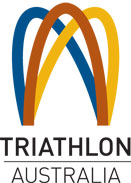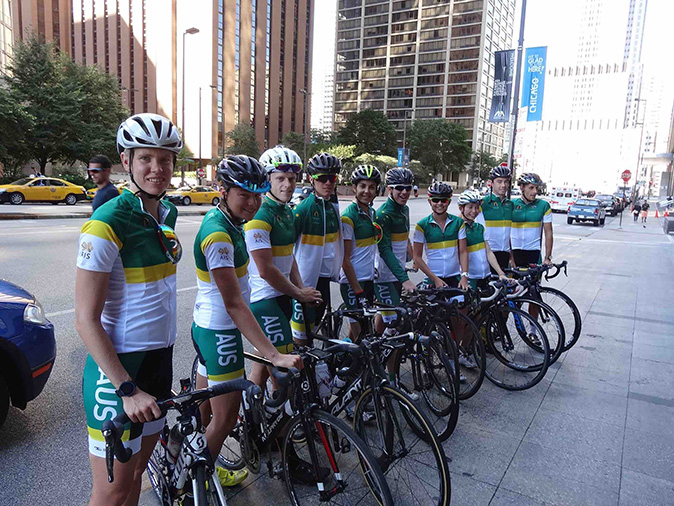Australian Paratriathlon Team’s 2020 vision
 Triathlon Australia, September 17, 2015: Australia has a vision of being the most successful nation at the World Paratriathlon Championships by 2020 and will field a very strong team in the Elite Paratriathlon race (7am Local Time and 10pm AEST on Friday 18th) at this year’s ITU World Championships in Chicago.
Triathlon Australia, September 17, 2015: Australia has a vision of being the most successful nation at the World Paratriathlon Championships by 2020 and will field a very strong team in the Elite Paratriathlon race (7am Local Time and 10pm AEST on Friday 18th) at this year’s ITU World Championships in Chicago.
Australia has 14 athletes entered here in Chicago, and is one of the larger teams competing, behind the USA and Great Britain.
The team has enjoyed a successful debut season in the World Paratriathlon Event circuit which began on the Sunshine Coast in March and leading the way will be two world champions Bill Chaffey and Sally Pilbeam and for the first time the inclusion of vision impaired athlete Katie Kelly and her guide, former ITU world champion Michelle Jones.

Here is your guide to the ITU Paratriathlon World Championship team:
WA’s 2014 World Champion Sally Pilbeam (PT3) and 2013 World Champion and four-time champion Bill Chaffey (PT1) are Australia’s leading medal contenders along with the new combination of Katie Kelly & Michellie Jones (PT5) who are making their ITU World Championships debut but are undefeated after three WPE races in 2015 (Sunshine Coast, Yokohama, Iseo). Jones, who teamed up with Kelly as her first time guide in Yokohama will be inducted into the Hall of Fame the night before the race.
Triathlon Australia Paratriathlon Team
PT1:
Emily Tapp (QLD)
Bill Chaffey (QLD) – Paralympic Class
Nic Beveridge (QLD) - Paralympic Class
PT2:
Brant Garvey (WA) - Paralympic Class
Glen Jarvis (NSW) - Paralympic Class
PT3:
Kerryn Harvey (VIC)
Sally Pilbeam (WA)
Justin Godfrey (VIC)
PT4:
Kate Doughty (VIC) - Paralympic Class
Claire McLean (WA) - Paralympic Class
Joshua Kassulke (QLD) - Paralympic Class
Jack Swift (VIC) - Paralympic Class
PT5:
Katie Kelly (ACT)/Michellie Jones - Paralympic Class
Jonathan Goerlach (ACT)/Daudi Somi
Triathlon Australia Paratriathlon Staff
Paratriathlon Manager: Kathryn Periac
Head Coach: Corey Bacon
Coaches: Fab Andreoni, Shaun D’Auria
Recovery/Soft Tissue: Scott Smith
Mechanic: Micko Brice
Handler: Darren Tattersall
PARALYMPIC GAMES: The low down
- Men’s classes: PT1, PT2, PT4
- Women’s classes: PT2, PT4, PT5
- There will be only 10 athletes in each class on the start line in Rio 2016.
- The winner of the race in Chicago in those classes qualifies one of the 10 places for the National Federation.
- The ITU Paralympic Ranking list runs from 1st July 2015 to 30th June 2016.
- The next 6 highest ranked athletes on this list will secure a slot for their NF. Last 3 places are invitations.
- Best of 3 scores to count so effectively Chicago (worth 700 points to the winner, then drop 7.5% each position) is the major qualifying event. The Continental Championships is worth 450 points (and for Australians will be Devonport in February) and that leaves one of the WPEs (worth 300 points) as the logical third qualifying score.
- Therefore the Australian athletes in Paralympic classes are focussed on securing the highest placing possible to boost their chances of Australia earning a qualification slot.
CHICAGO: AUSSIES TO WATCH
Here is a look at the Australian team:
- Sally Pilbeam (PT3): The Perth schoolteacher and mother of two, who lost her right arm to cancer, won her maiden world title in Edmonton last year. Will again be one to watch in a field that will also include her team mate:
- Kerryn Harvey (PT3) – Who won the WPE Sunshine Coast, then focussed on riding her bike from Perth to Melbourne in April to promote her foundation and raise funds for the Adelaide Hospital which saved her life after an accident saw her lose her right arm. This will be her World Championships debut.
- Katie Kelly (PT5): A former triathlete in her own right, Katie was born with the rare genetic condition Usher syndrome, resulting in hearing and eyesight loss, which deteriorates over time. And in January this year, the 40-year-old Canberra resident discovered she was legally blind and embarked on a new career path she hopes will take her to Paratriathlon glory in Rio next year and she is taking ITU Hall of Famer, Michellie Jones along for the ride, as her guide.
- Bill Chaffey (PT1): Missed last year’s world championship when he fell and broke a bone in his hip on the eve of the Championships. But he has bounced back better and faster than ever with victories on the Sunshine Coast, Sydney, London and the Rio Test Event, where he crashed, came back and still won.
- Emily Tapp (PT1) – Won Sunshine Coast and Yokohama and 2nd at Detroit WPEs, debut at World Championships. The youngest on the Australian Paratriathlon team, the 24-year-old continues to improve at every start. She became a paraplegic after a camp drafting accident just four-weeks out of school in 2010.
- Kate Doughty (PT4) – After finishing 2nd to teammate Claire McLean at Sunshine Coast Kate won Yokohama and finished 3rd at the Detroit WPE recently. Will debut at the World Championships. A former Para-Equestrian star, who started racing triathlon this year after a successful international career as an Equestrian competitor. The daughter of a Melbourne bookmaker who sold her horse and bought a bike and is improving with each race.
- Claire McLean (PT4) - The 2004 Paralympic cycling silver medallist in Athens, McLeanwas 7th at World Championships in Edmonton.
- Brant Garvey (PT2) The Albany congenital above-knee amputee was 6th at the ITU World Championships in Edmonton last year and has been progressing steadily throughout 2015, winning the Sunshine Coast WPE.
- Glen Jarvis (PT2) An Albury-Wodonga local who made his name as a Paracyclistsince finishing fourth at the World Championships in 2002, Jarvis has built up his Paratriathon repertoire with two fourths in Yokohama in 2014 and 15 after finishing second at the WPE to Brant Garvey on the Sunshine Coast.
- Justin Godfrey (PT3) won Sunshine Coast and was 3rd at Yokohama WPE. He also finished 6th at Edmonton in 2014. The Albury PT3 athlete, finished 6th at World Championships in 2014. He is coming back into good form following successful surgery to improve his stump to better support the demands of Elite Paratriathlon racing.
- Nic Beveridge (PT1) An athlete very much on the rise and At 28, Beveridge is earmarked for a bright future in the sport with the men’s PT1 built for athletes in their early to mid 30s. The 2016 Commonwealth Games and Tokyo 2018 will be his peak opportunities.
- Jack Swift (PT4)Melbourne’s London track and field Paralympian the swift-moving leg amputee, led the way to win the opening WPE round on the Sunshine Coast, with an outstanding win, sending a clear message that he means business as he seeks a place on his second Paralympic team for Rio. Swift, who ran in the 400 and 4x100m in London and who lost the lower part of his right leg after a work accident in 2006, aged 21.
- Jonathan Goerlach (PT5): Jonathan finished 10th in his class for vision impaired athletes at last year’s ITU World’s in Edmonton. He had previously won the OTU Oceania at Penrith in 2014 and the Elwood OTU WPE event at Elwood and was fifth in Chicago. Returns to the World Championships with his original guide Daudi Somi.
- Joshua Kassulke (PT4): Finished eighth in his WPE debut WPE in Edmonton. Came onto the scene in March at the National Championships, and started training with Josh White. A PT4 athlete who lost part of his arm in a workplace accident. A new comer, he remains on the waitlist for the World Championships, and may not get on the start list. If not he will race the Open race on the Saturday.
CLASSIFICATONS
- PT 1: Athletes with mobility impairments such as muscle power, limb deficiency, hypertonia, ataxia or athetosis that render them incapable of safely running or pedalling a bicycle. Athletes use a recumbent handcycle during the cycling stage and a racing wheelchair for the running phase of the race.
- PT 2, 3, 4: For athletes with mobility impairments such as muscle power, limb deficiency, hypertonia, ataxia or athetosis, depending on their classification assessment scores. Amputees may use approved prostheses or supportive devices during the running and cycling stages.
- PT5:Athletes with a visual impairment. All qualifying levels of visual impairment, IBSA/IPC defined sub-classes B1, B2, and B3, are grouped together in this classification. Athletes must have a sighted guide of the same gender and nationality during the entire race and use a tandem bicycle during the cycling stage.
Issued on behalf of Triathlon Australia by
Ian Hanson| Media Manager Triathlon Australia

Ian Hanson| Media Manager Triathlon Australia Managing Director
Hanson Media Group | P O Box 299 | West Burleigh Qld 4219
Phone: +61 7 5522 5556 | Mobile 0407 385 160 | Fax: +61 7 5522 5557
This email address is being protected from spambots. You need JavaScript enabled to view it. | www.hansonsportsmedia.com.au